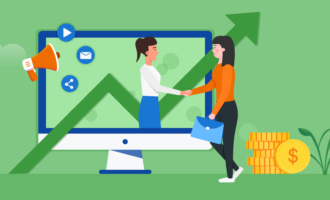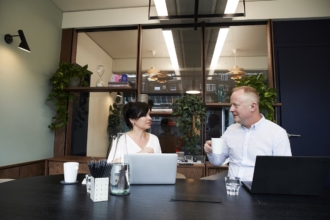The marketing funnel describes the stages of the buyer’s journey, from discovering a need to purchasing your product to solve their problem. Understanding the funnel will help you clarify your marketing tactics at every step. This is crucial in business-to-business (B2B) marketing, where each stage of the buyer’s journey takes longer than the typical business-to-consumer (B2C) funnel.
The concept of a marketing funnel is older than you probably realize. The legendary advertiser Elias St. Elmo Lewis developed the concept in 1898. His classic sales model contains four stages of buyer behavior: attention, interest, desire, and action (known as AIDA). The sales funnel strategy calls for businesses to tailor their outreach in order to entice prospects from one stage to the next, ultimately culminating in a sale.
The Lewis model has been continually tweaked, modified, and reconceptualized by marketers for 120 years. Here’s how marketers today conceptualize the B2B marketing funnel.
Stage 1: Awareness
At the absolute top of the B2B marketing funnel, your prospect realizes they need something they don’t have. They know that services or products like yours are out there, but they haven’t started researching particular brands.
The awareness stage kicks off the buyer’s journey. An employee researching a purchase at this stage isn’t ready for detailed case studies and ROI calculations. “Unlike in B2C, an individual may be tasked with finding brands in the B2B space,” says Livia Orencak, marketing manager at GoSquared. “[They] might not even be clear on the ultimate reason for the buying decision.”
In other words, focus on producing high-quality information about your subject in a top-of-funnel campaign rather than advertisements.
Pro Tip
Automate your B2B marketing funnel with Jotform’s powerful online forms and automation features.
Stage 2: Interest
Your audience is every business seeking a product or business solution to help them meet a need or solve a problem. In the interest stage, your prospect learns who the players are in the market and begins to research them.
At this stage, “buyers are researching products and looking at reviews,” says Toni JV, SEO consultant and founder of JVT Media. A visible reputation is essential for success in the interest phase of the B2B marketing funnel. “Make sure you have plenty of five-star reviews and positive customer experiences,” he says.
Stage 3: Consideration
At this point, your prospect has completed the necessary research and refines it for broad consideration internally.
“The buyer might add vendors to a list, with a checklist of capabilities, and share this around internally,” says Orencak. “Other members of the business are likely to get clearer on their needs and objections at this stage. This is not something that happens in B2C [marketing].”
Branding comes into play at this stage, as well, says JV.
“When people share your work with their business partners and stakeholders, and you have a strong, established brand behind you, people will trust you more,” he says.
Stage 4: Intent
In a B2C transaction, stage four begins when the shopper puts an item in their basket. They’re signaling intent to purchase — but there’s still a chance they’ll abandon the cart.
The intent stage of the B2B sales funnel involves far more deliberation. At this stage it’s common for service providers to give the prospect a polished demonstration. This strengthens the prospect’s intent. JV advises B2B companies to “overdeliver on value and service when you deliver your demo.”
Stage 5: Evaluation
At the evaluation stage, your prospect is serious about partnering with your business and wants to hammer out the details of the deal. They have your proposal and are dissecting it internally.
“Often, the buyer will work through their prioritized list of vendors until they find one that will deliver on everything required,” warns Orencak.
Stage five is delicate. Be willing to work with prospects until you have a deal that checks all their boxes.
Stage 6: Purchase
This is the bottom of the funnel, the moment you’ve been working toward. Depending on your business, this could be a one-time purchase or an ongoing contract, but it’s your payday.
There are other models of marketing funnels, some with fewer steps and some with more. Regardless of which model you choose, experiment with varying strategies at each stage to improve your results.
Business photo created by yanalya – www.freepik.com






































































Send Comment: